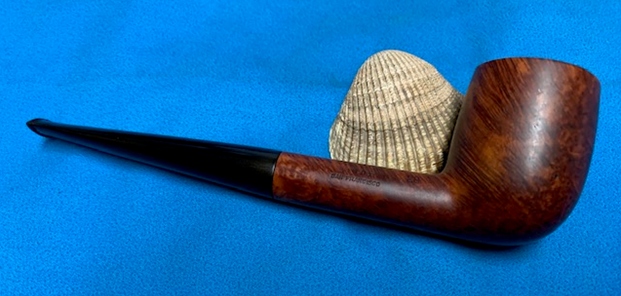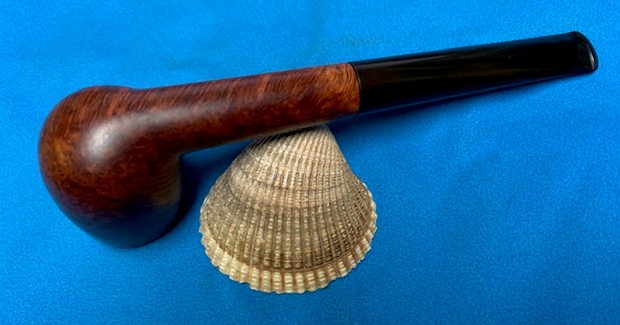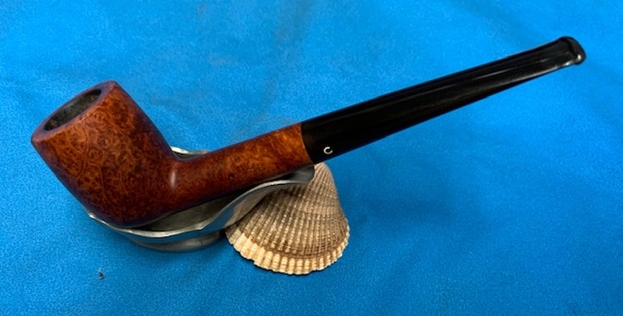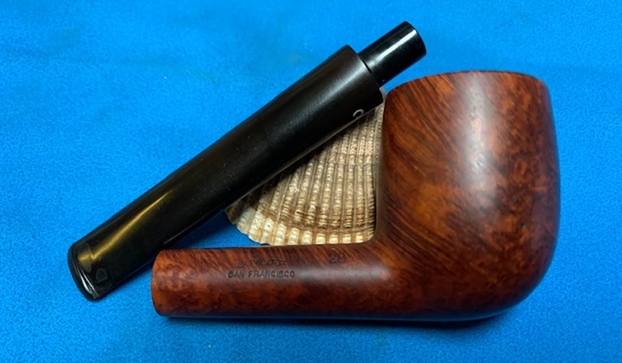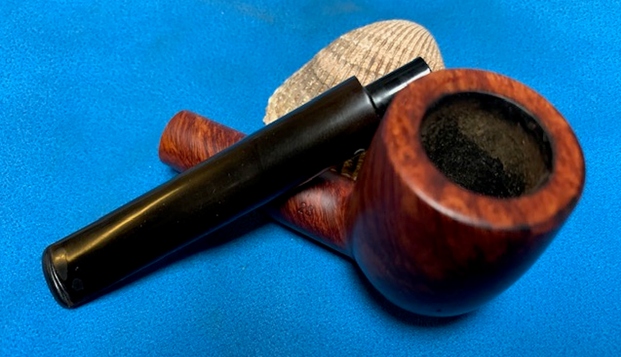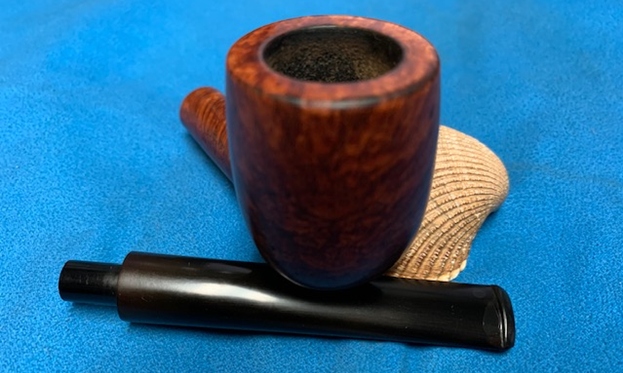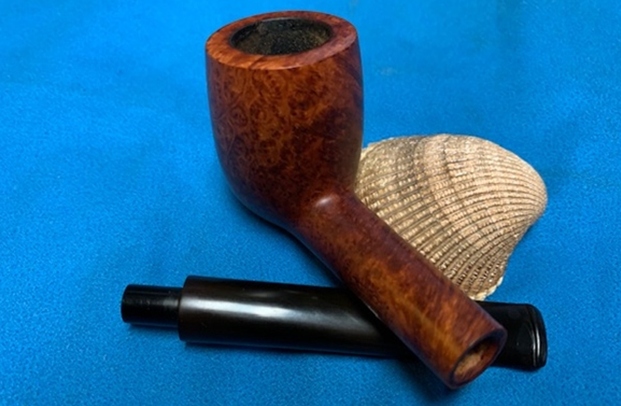Blog by Steve Laug
The next pipe on the work table came to me from one of our estate purchases. It is a beautifully grained Comoy’s Billiard that really is a pipe of Pipe Smoking History. The stamping is the significant marker that points this out for me. It is stamped on the left side of the shank and reads COMOY’S arched [over] Virgin Briar. On the right side it has the shape number 28 next to the bowl/shank junction and that is followed by Sutliff [over] San Francisco. On the underside next to the stem/shank junction it is stamped with the football shaped Comoy’s COM stamp that reads Made in England. The finish had a lot of grime ground into the smooth finish on the bowl and some darkening around the sides of the bowl. The bowl was heavily caked and had an overflow of thick lava on the top of the rim. It was hard to know what the rim top and inner edge of the bowl looked like under the grime. The stem was calcified, oxidized and had tooth chatter and large deep tooth marks on the top and underside but the surface of the button was surprisingly free of damage. There was a three part inlaid C on the left of the taper stem. The pipe had promise but it was very dirty. Jeff took photos of the pipe before he started his cleanup work. 
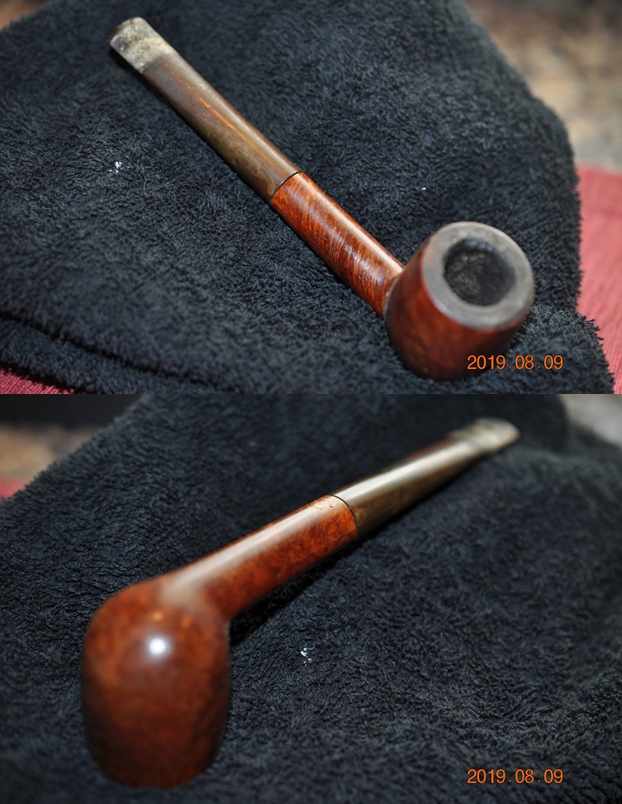 He took photos of the rim top and bowl to give a clear picture of the thickness of the cake and the overflow of lava on the rim top. It is hard to know if there is damage to the inner edge of the bowl because of the lava coat. He also took photos of the top and underside of the stem to show the oxidation, calcification, chatter and deep tooth marks.
He took photos of the rim top and bowl to give a clear picture of the thickness of the cake and the overflow of lava on the rim top. It is hard to know if there is damage to the inner edge of the bowl because of the lava coat. He also took photos of the top and underside of the stem to show the oxidation, calcification, chatter and deep tooth marks. 
 Jeff took photos of the sides and heel of the bowl to give a picture of what the briar around the pipe looked like. There is some stunning grain under the grime. You can also see some of the damage around the outer rim edge.
Jeff took photos of the sides and heel of the bowl to give a picture of what the briar around the pipe looked like. There is some stunning grain under the grime. You can also see some of the damage around the outer rim edge.  He took photos of the stamping on both sides and underside of the shank. They read as noted above. He also included a photo of the stamping on the left side of the taper stem.
He took photos of the stamping on both sides and underside of the shank. They read as noted above. He also included a photo of the stamping on the left side of the taper stem. 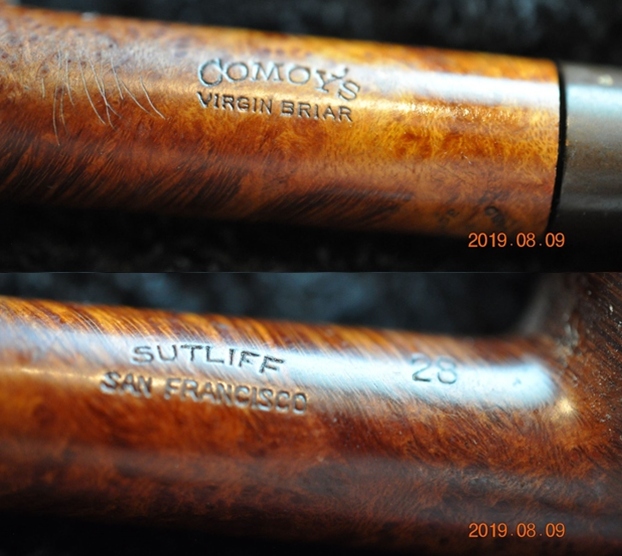
 I looked on Pipephil’s site for information on the Comoy’s Virgin Briar and found the following information I have included a screen capture below (http://www.pipephil.eu/logos/en/logo-comoy.html). It is interesting that the Virgin Briar originally came out in 1933 and by 1965 was no longer listed in the Comoy’s catalogues. The example on Pipephil was crafted fro the 1933 Chicago World’s Fair in 1933.
I looked on Pipephil’s site for information on the Comoy’s Virgin Briar and found the following information I have included a screen capture below (http://www.pipephil.eu/logos/en/logo-comoy.html). It is interesting that the Virgin Briar originally came out in 1933 and by 1965 was no longer listed in the Comoy’s catalogues. The example on Pipephil was crafted fro the 1933 Chicago World’s Fair in 1933.  I also went to the the Comoy’s article on Pipedia and found nothing in the great historical article that was pertinent. I did find a shape chart that listed the 25 as a medium billiard. I have included a screen capture of the page that included that shape number. I have outlined it in red in the photo included below(https://pipedia.org/images/d/d7/Shape_Chart_1975_1.jpg).
I also went to the the Comoy’s article on Pipedia and found nothing in the great historical article that was pertinent. I did find a shape chart that listed the 25 as a medium billiard. I have included a screen capture of the page that included that shape number. I have outlined it in red in the photo included below(https://pipedia.org/images/d/d7/Shape_Chart_1975_1.jpg). I turned to the article on Pipedia about dating Comoy’s pipes but the style of the stamping (https://pipedia.org/index.php?title=Comoy%27s_Dating_Guide#1917_to_the_end_of_the_1930.27s_.28at_least_1938.29). I have include the section in the screen capture below that date this pipe to the 1930s.
I turned to the article on Pipedia about dating Comoy’s pipes but the style of the stamping (https://pipedia.org/index.php?title=Comoy%27s_Dating_Guide#1917_to_the_end_of_the_1930.27s_.28at_least_1938.29). I have include the section in the screen capture below that date this pipe to the 1930s.
1917 to the end of the 1930’s (at least 1938)
The slightly fancy “COMOY’S” can be found stamped in a curve, in upper case script with serifs, apostrophe before the “S,” and the “C” larger than the other letters. The arched “COMOY’S” with serifs and apostrophe may have been continued for a short time after the WW I. Pipes can also be found with the name stamped across the top of the stem as apposed to along the side.
Not many pipes were made. It seems that the “COMOY’S” was stamped as described above, with the grade of the pipe (quality) stamped in block letters below. Just after WW II, in 1945 or slightly later, the “COMOY’S” stamp was changed from the fancier curve to a straight line, sans serif, block lettered “COMOYS”, with no apostrophe, see No 3 below in “From the 1950s”.
That article gave me some helpful information. I knew that the pipe line originally came out in 1933 at the time of the Chicago World’s Fair. From the information I also knew that the stamping on the pipe I am working on also came from the 1930s – 1945 when the arched Comoy’s stamp was changed. The 28 shape number was tied to a Medium Billiard with a taper stem. I still needed to check for information on the Sutliff San Francisco stamp on the right side of the shank.
I found an article online about the Sutliff Tobacco Company in San Francisco that gave a bit of the history of the company (https://tobaccobusiness.com/sutliff-tobacco-company-editorial/). I have included a pertinent section of the article below.
When H.W. Sutliff established Sutliff Tobacco Company in San Francisco in 1849, California had yet to become a state. Sutliff established his company as a tobacco retailer, and, like so many tobacco retailers of his day, he created his own pipe tobacco blends for his clientele. As the city grew, so did Sutliff Tobacco Company, and, by the time of San Francisco’s great earthquake of 1906, the company had a well-established reputation for providing good-quality pipe tobaccos and other tobacciana. Remaining within the Sutliff family, Sutliff Tobacco Company’s pipe tobaccos also grew in popularity within the region, and by the 1930s, the company enjoyed national sales for its Mixture 79, a non-aromatic cube-cut burley-based blend, which it introduced in 1933.
It is interesting to note that by the 1930s the company had international sales for its Mixture 79 tobacco which was introduced in 1933. This links in nicely with the time period of the pipe. I wonder if the 1933 World’s Fair in Chicago pushed them to have Comoy’s make a pipe for them with their name on it to go along with the tobaccos they shipped around the US.
Since Jeff follows the same pattern of work in his cleanup we do not include photos but rather just a simple summary. Jeff reamed the bowl with a PipNet pipe reamer and followed up with a Savinelli Fitsall pipe knife to remove the cake. He scrubbed out the mortise and the airway in the shank and the stem with alcohol, cotton swabs and pipe cleaners. He scrubbed the exterior of the bowl, rim, shank and stem with a tooth brush and Murphy’s Oil Soap to remove the oils and tars on the rim and the grime on the finish of the bowl. He rinsed it under running water. He dried it off with a soft cloth. He was able to remove the lava build up on the rim top and you could see the damages to the top and edges of the rim. I think this pipe may well been before we worked with Mark Hoover’s Before & After Deoxidizer so he cleaned the internals and externals. The stem was clean but lightly oxidized. I took photos of what the pipe looked like when I brought to my worktable.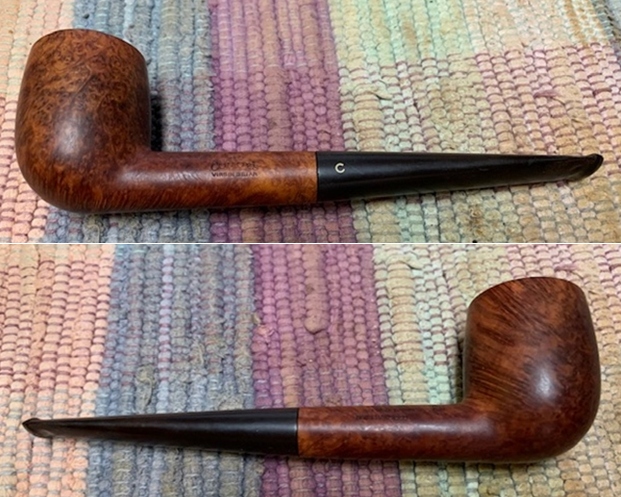
 The rim top cleaned up really well with the lava coat removed. The inner edge of the rim showed some damage and burning on the front and back edges. There was also some damage on the rim top at the front. The stem surface looked very good with some light oxidation remaining and some deep tooth marks on both sides ahead of the button.
The rim top cleaned up really well with the lava coat removed. The inner edge of the rim showed some damage and burning on the front and back edges. There was also some damage on the rim top at the front. The stem surface looked very good with some light oxidation remaining and some deep tooth marks on both sides ahead of the button.  I took photos of the stamping on the shank sides and underside. It reads as noted above.
I took photos of the stamping on the shank sides and underside. It reads as noted above.  I removed the stem and took a photo of the pipe to give a sense of the whole. It is a well shaped billiard. Once the stem was off I noted that the airway in the tenon was quite large. Given the information that some of the Virgin Briar had a Comoy’s Grand Slam metallic stinger I checked for threading and sure enough the tenon was threaded. I tried several Grand Slam stingers that I have here and all were too long and too big to fit in the shank. But at least I knew that it had one in the past.
I removed the stem and took a photo of the pipe to give a sense of the whole. It is a well shaped billiard. Once the stem was off I noted that the airway in the tenon was quite large. Given the information that some of the Virgin Briar had a Comoy’s Grand Slam metallic stinger I checked for threading and sure enough the tenon was threaded. I tried several Grand Slam stingers that I have here and all were too long and too big to fit in the shank. But at least I knew that it had one in the past. Now it was time to do my work on the pipe. I started by dealing with the rim top and edge damage. I topped the bowl on a topping board with 220 grit sandpaper to remove the rim top damage. I reworked the rim edges smoothing out the damaged areas. The rim top looks much better.
Now it was time to do my work on the pipe. I started by dealing with the rim top and edge damage. I topped the bowl on a topping board with 220 grit sandpaper to remove the rim top damage. I reworked the rim edges smoothing out the damaged areas. The rim top looks much better.
 I polished the bowl and the rim top, sides and shank with micromesh sanding pads – wet sanding with 1500-12000 grit pads and wiping it down after each pad with a damp cloth. I carefully avoided the stamping on the top and underside of the shank so as not to damage the already faint stamping. Between the 2400 and the 3200 grit pad I stained the top of the rim with a Maple Stain Pent to match the colour of the bowl. I polished it with the rest of the pads and the blend was good.
I polished the bowl and the rim top, sides and shank with micromesh sanding pads – wet sanding with 1500-12000 grit pads and wiping it down after each pad with a damp cloth. I carefully avoided the stamping on the top and underside of the shank so as not to damage the already faint stamping. Between the 2400 and the 3200 grit pad I stained the top of the rim with a Maple Stain Pent to match the colour of the bowl. I polished it with the rest of the pads and the blend was good. 
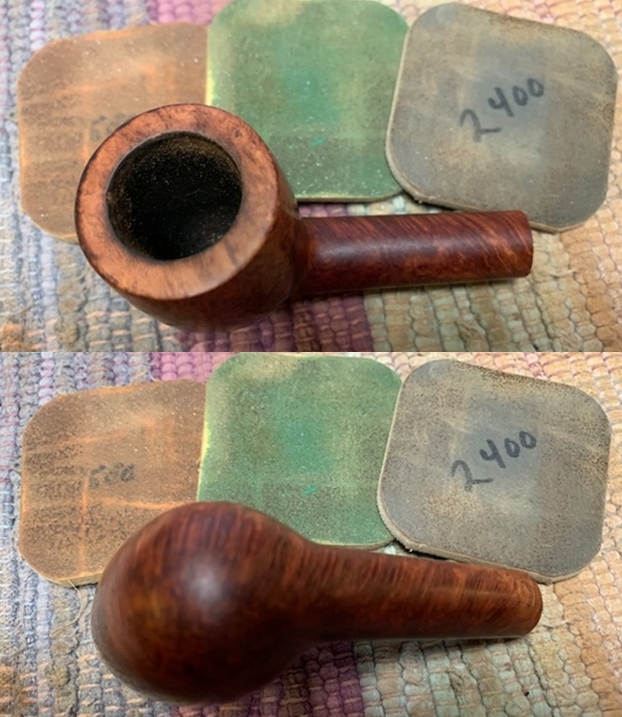
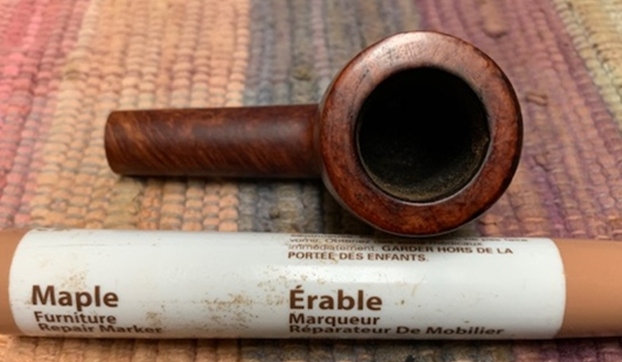
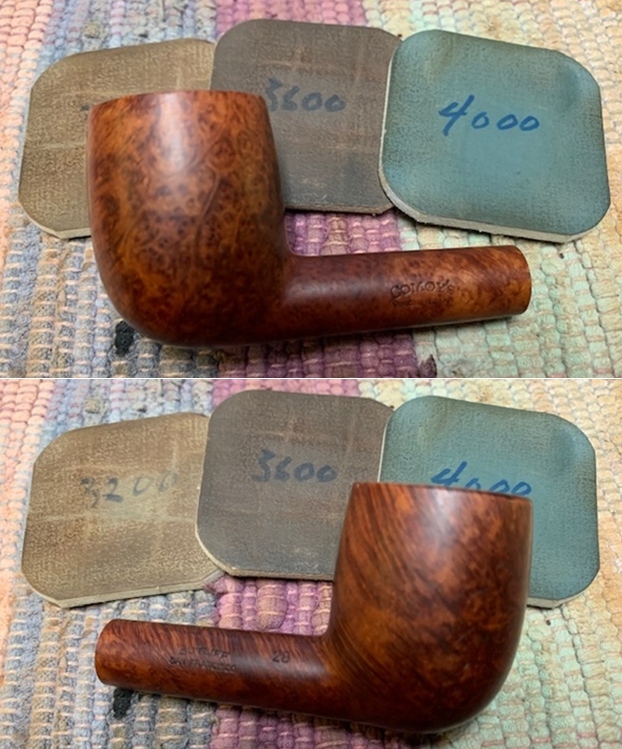
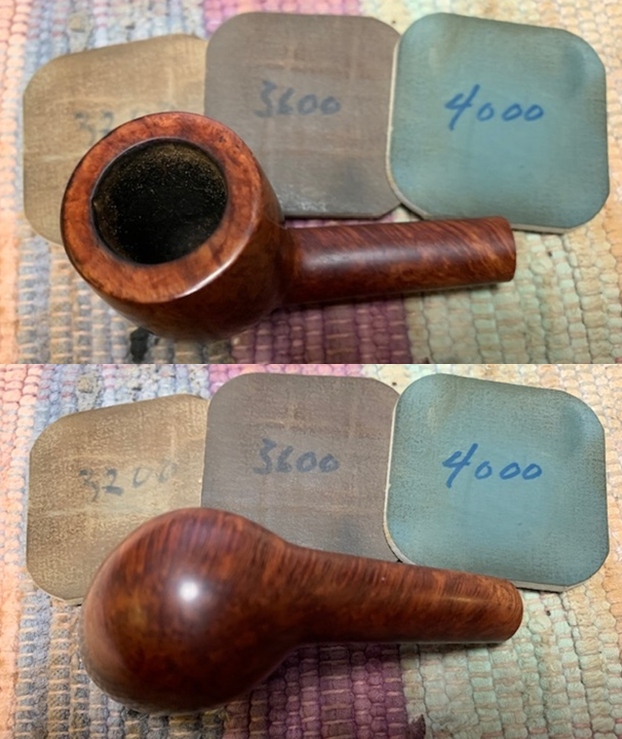

 I rubbed the bowl and shank down with Before & After Restoration Balm. I worked it into the surface of the bowl sides and shank with my fingertips to clean, enliven and protect the briar. I let the balm sit for a little while and then buffed with a cotton cloth to raise the shine.
I rubbed the bowl and shank down with Before & After Restoration Balm. I worked it into the surface of the bowl sides and shank with my fingertips to clean, enliven and protect the briar. I let the balm sit for a little while and then buffed with a cotton cloth to raise the shine.
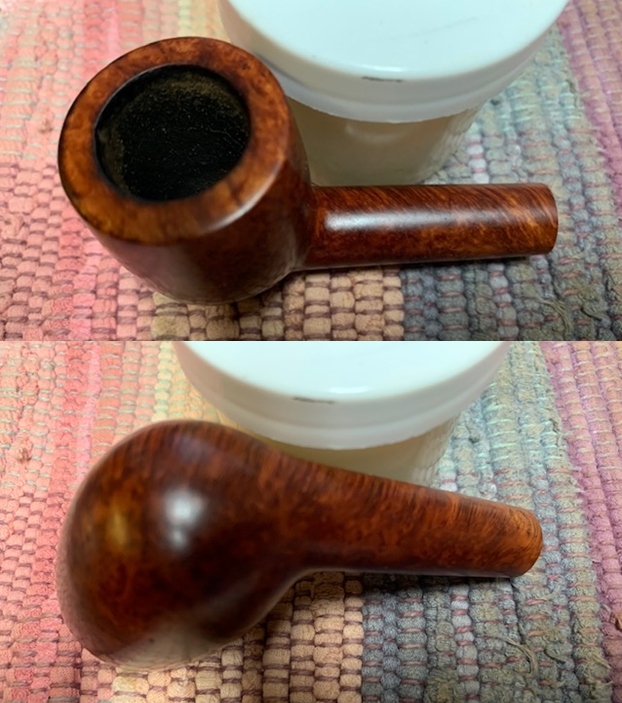
 I set the bowl aside and turned my attention to the stem. I “painted” the stem surface to raise the tooth marks and the small ones lifted some. You can see what they looked like in the photos below. I filled in the dents and built up the edge of the button on both sides with black Loctite 380 CA. I set the stem aside to let the repairs cure.
I set the bowl aside and turned my attention to the stem. I “painted” the stem surface to raise the tooth marks and the small ones lifted some. You can see what they looked like in the photos below. I filled in the dents and built up the edge of the button on both sides with black Loctite 380 CA. I set the stem aside to let the repairs cure. 
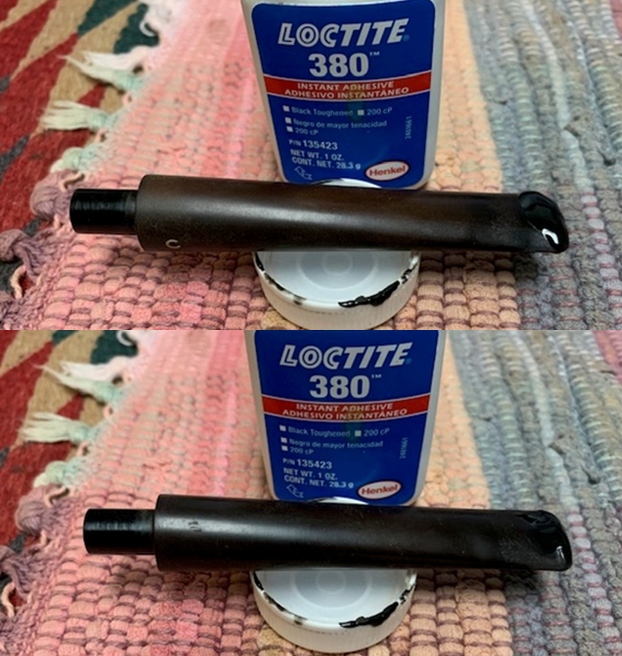 Once the repairs cured I recut the button edge and flattened out the repaired areas with a needle file to begin to blend them into the surface.
Once the repairs cured I recut the button edge and flattened out the repaired areas with a needle file to begin to blend them into the surface.  I sanded the stem with 220 grit sandpaper to further blend them in and followed that by starting the polishing with 400 grit wet dry sandpaper.
I sanded the stem with 220 grit sandpaper to further blend them in and followed that by starting the polishing with 400 grit wet dry sandpaper.  I polished the vulcanite stem with micromesh sanding pads – 1500-12000 grit pads. I wiped it down with a damp cloth after each sanding pad. I used Before & After Pipe Polish – both Fine and Extra Fine to further polish the stem.
I polished the vulcanite stem with micromesh sanding pads – 1500-12000 grit pads. I wiped it down with a damp cloth after each sanding pad. I used Before & After Pipe Polish – both Fine and Extra Fine to further polish the stem. 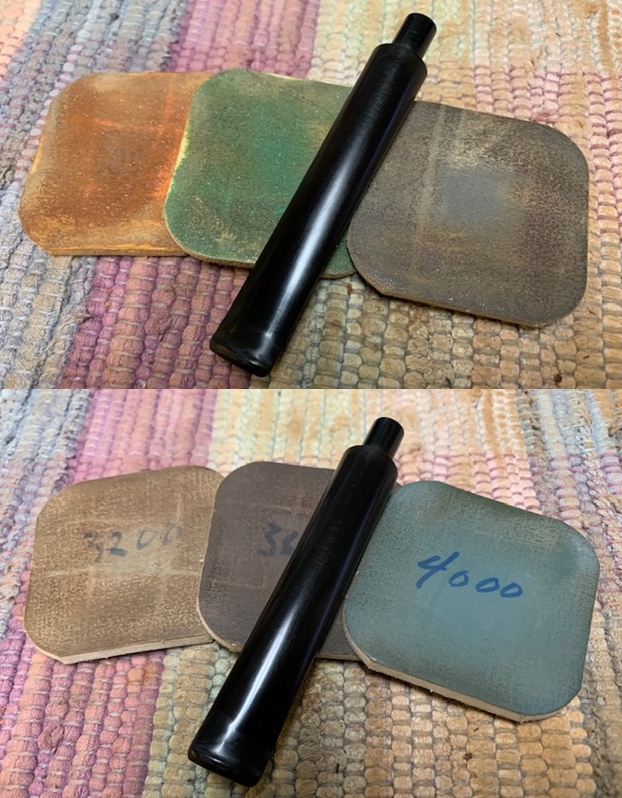
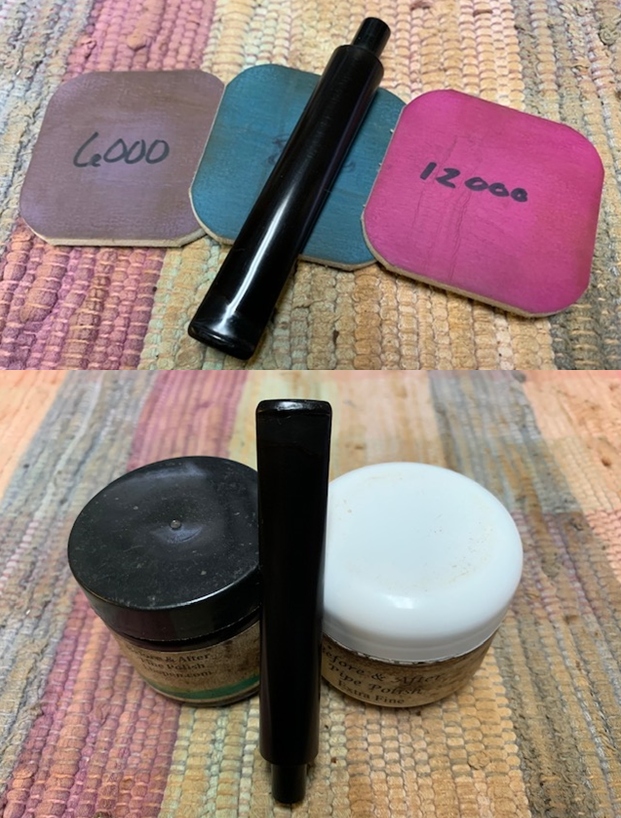 This gorgeous Comoy’s Virgin Briar 28 Billiard with the Sutliff San Francisco stamp and a vulcanite taper stem is a great looking pipe now that it has been restored. The rich browns and blacks of the contrasting stains came alive with the polishing and waxing. I put the stem back on the bowl and carefully buffed the pipe with Blue Diamond on the buffing wheel using a light touch on the briar. I gave the bowl and the stem multiple coats of carnauba wax on the buffing wheel and followed that by buffing the entire pipe with a clean buffing pad. I hand buffed the pipe with a microfiber cloth to deepen the shine. The finished Comoy’s Medium Billiard is a beauty and fits nicely in the hand and looks very good. Give the finished pipe a look in the photos below. The dimensions of the pipe are Length: 6 inches, Height: 1 ¾ inches, Outside diameter of the bowl: 1 ¼ inches, Chamber diameter: ¾ of an inch. If you are interested in adding this pipe to your collection send me a message or an email. Thanks for reading this blog and my reflections on the pipe while I worked on it. There are many more to come!
This gorgeous Comoy’s Virgin Briar 28 Billiard with the Sutliff San Francisco stamp and a vulcanite taper stem is a great looking pipe now that it has been restored. The rich browns and blacks of the contrasting stains came alive with the polishing and waxing. I put the stem back on the bowl and carefully buffed the pipe with Blue Diamond on the buffing wheel using a light touch on the briar. I gave the bowl and the stem multiple coats of carnauba wax on the buffing wheel and followed that by buffing the entire pipe with a clean buffing pad. I hand buffed the pipe with a microfiber cloth to deepen the shine. The finished Comoy’s Medium Billiard is a beauty and fits nicely in the hand and looks very good. Give the finished pipe a look in the photos below. The dimensions of the pipe are Length: 6 inches, Height: 1 ¾ inches, Outside diameter of the bowl: 1 ¼ inches, Chamber diameter: ¾ of an inch. If you are interested in adding this pipe to your collection send me a message or an email. Thanks for reading this blog and my reflections on the pipe while I worked on it. There are many more to come! 
